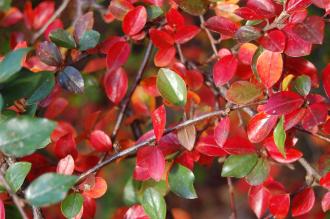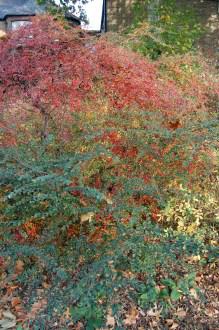
Cotoneaster divaricatus autumn leaf (01/11/2011, London)
Position: Full Sun to partial shade
Flowering period: Spring to early Summer
Soil: Well drained
Eventual Height: 2m
Eventual Spread: 3m
Hardiness: USDA Zones 4a – 7b
Family: Rosaceae
Cotoneaster divaricatus is a medium sized deciduous shrub with an upright, columnar growth habit, becoming horizontal and spreading with age. It’s foliage is dark, glossy green in color. It’s leaves are 2cm long, alternate, elliptical, with flattened, entire margins. The leaves of this plant turn bright red in autumn. The stems of the plant are purple/ brown in color and have a waxy coating that flakes off with age. The hermaphrodite flowers of the plant are held tightly against the stems, blossoming in late May and early June. They are borne from pink buds to small 5 petalled and are white or pink and are numerous. The 1cm fruits of the plant are egg shaped and are bright red in color.
C. divaricatus, commonly known as Spreading Cotoneaster, is native t0 west China. This plant was introduced into the UK in 1904 as a garden species. In 1983 it was recorded in the wild in Kent, probably bird sown, and it is suspected that it may be spreading.
The etymological root of the binomial name Cotoneaster is derived from the old Latin name cotone ’quince’, aster being a Latin substantival suffix indicating ‘resembling’. Divaricatus is derived from the Latin meaning ‘spreading out’ or ‘growing in a straggly manner’.

Cotoneaster divaricatus autumn (01/11/2011, London)
The landscape architect may find Cotoneaster divaricatus useful as an impenetrable informal hedge. It can be planted en mass to great effect due to it’s autumn color. It is also tolerant of urban conditions and some salt exposure.
Ecologically this plant is pollinated by flies, bees and midges.
B. thunbergii will tolerate most soils although it prefers well drained soil. It is tolerant most soil pH. It will tolerate poor soils and soil compaction.
Maintenance: This plant requires little maintenance. Hedge maintenance should be carried out in late winter.

